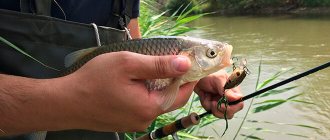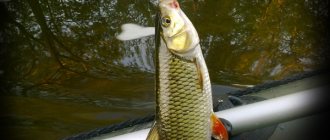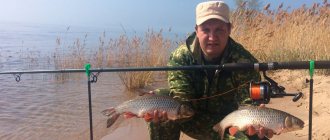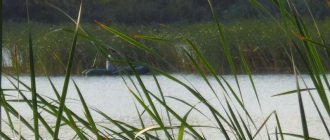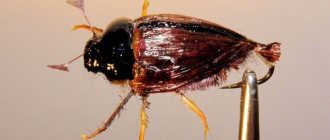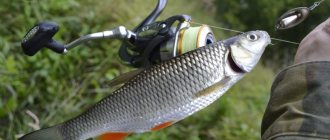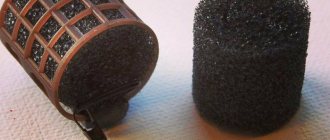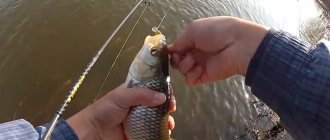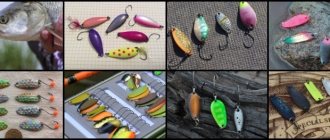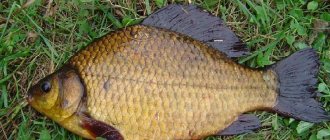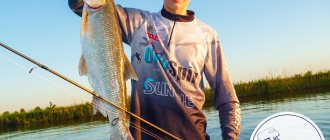Float rods
Chub fishing is often done using float rods. The following can be used:
- match;
- flight feathers;
- Bolognese tackle.
When fishing with float rods, you must use bait. When choosing a fly or Bolognese fishing rod, choose floats that are stable and can withstand the force of the current. The shape of the float is selected according to the fishing conditions. Basically, fishermen choose a round float.
Everything about a hook is important: thickness, shape, elasticity, shank length. Size can be taken from No. 1.0 to No. 18.0. Sinkers are taken in the form of a drop or a pellet.
Donkey suppliers
This option is chosen by beginners and those who are on a limited budget. Making the product is very simple. You will need: thick fishing line, a rod-whip equipped with a reel, a flat heavy sinker. Hooks should be large - use 1-3 pieces. The equipment is secured to the reel. During casting, a loop is made, which is put on the whip. The casting distance is also determined by the loop.
We also recommend reading:
Catching perch in winter on a balancer Catching bream in December 2021 Catching perch in the grass Features of winter fishing for bream
A bell is used as a signaling device. Before throwing the fishing line, it is wound into rings from the reel and placed on the ground. At the same time, it is important to ensure that it does not catch on anything and become entangled.
Spinning
First of all, when choosing a spinning rod, attention is paid to the weight of the product. The tackle should be not just light, but ultra-light. The leash is taken to be almost invisible - a steel wire of 0.16 mm or a vein of 0.3 mm. It is important to carry out cutting correctly. The spinning rod should work well with any bait.
Chub fishing often occurs with rotating small spoons. The color of the bait should be natural. They catch fish behind the rifts with a spinning rod. As soon as the spoon sinks to the bottom, a calm retrieve is performed. When throwing a spinning rod in a fast current, the spinner is placed across the current, and at the rapids the rotation of the reel stops. In this case, the spinner will play on its own, which the chub will certainly like.
Chub: description and behavioral characteristics
Chub is a fish of the carp family that lives in freshwater reservoirs, has a strong, large body and a large head with a large sloping forehead. It is thanks to the large head that the fish received the name “chub”.
In open waters, it feeds mainly on plant foods or hunts for aerial insects, jumping out of the water. Chub, like carp and bream, love to dig into the silty bottom. And being in muddy waters is the favorite pastime of this extraordinary fish.
Many years of observations by aquatic hunters have led to the discovery of the fact that the chub likes to find a parking spot near steep, almost collapsed, banks, where, as a rule, there is always a lot of food. Chubs choose spawning sites in reed thickets, laying eggs alone. The female can lay eggs either in one portion or in several. Young individuals stay in small flocks, while large, no longer young individuals prefer to separate from the flock.
The record set in Russian rivers gave reason to believe that chubs in size can reach a length of up to 70 centimeters and weigh more than 5 kilograms. In Europe, the largest chub was an eighty-centimeter individual weighing 8 kilograms. Although usually the size of the fish does not exceed 30 centimeters, and the weight rarely reaches 4 kilograms.
An adult chub is a shy and extremely cautious fish; it reacts warily to the appearance of a person near a reservoir and immediately descends to the bottom of the river. Perhaps it is the difficulty of catching chub that makes it so popular among fishing enthusiasts. Chub meat is much tastier and fattier than the meat of bream and ide, but there is one drawback - it is very bony, so people try to cook fish soup from such fish or stew large pieces with vegetables. in sour cream sauce.
There are many manuals and video tutorials that tell you how to catch chub correctly, but it’s not always possible to get it.
Feeder and picker tackle
Chub fishing with picker gear and feeder occurs in the fall on the Oka River. But since the results were good, the presented gear began to be used in other regions. The feeder and picker are more graceful, and the quivertip quickly signals a bite.
When moving around a pond, you should give preference to English bottom tackle. The upper flexible part of the rod will also tell you about the bite, and there will be no need to use a bell.
From a boat and shore, chub fishing is done using picker tackle; in this case, the wiring is stepped. It is important to choose the right sinker according to the strength of the current so that it helps to catch fish. In this case, a braided fishing line with a minimal cross-section is used; it is securely installed in the river and is less easily carried away by the current.
Donka with a feeder
The bottom fishing rod, if you prefer it, should be short and powerful. The sinker is chosen flat. Live bait is often used as bait. The cuts are made sharply and briefly.
A bottom fishing rod with a reel allows you to place a feeder. As a result, the fish, enjoying the feeding, forgets about caution and gets hooked. At the same time, the bait is not carried away by the current. But in the fall it will not be easy to catch a chub on such a structure, since at this time it is already moving away from plant food.
You can use both open and closed feeders. Open products consist of a wire frame with mesh and a lead load. They are filled with plant bait with a small amount of animal components. Flavoring occurs using vegetable oil or cake.
Closed feeders are made of plastic. They have special holes through which the larvae are removed. The type of fastening for both products is fixed or sliding.
On a quiet river, you can use a donk with a rubber shock absorber. The bait is a small fish. Advantages of the tackle: when using it, there is no need for constant casting; it can be used from 5 hooks at once.
The elastic band allows you to stop at several attachments at once. When fishing in the upper part of the water it can be:
- bleak;
- roach;
- Verkhovka
Plant baits and insect larvae are used both in the water column and when fishing from the bottom.
Lures for chub
Best Natural Lures
The most popular baits of plant origin include:
- sweet dough;
- steamed peas, soy;
- steamed grain;
- boiled corn;
- boiled potatoes;
- filamentous algae;
- gooseberries, cherries, black currants;
- pieces of white bread;
Catchy baits of animal origin include:
- Pieces of lard.
- Raw veal liver.
- Chicken giblets , fish eyes, meat.
- Fry of bleak , dace, small crucian carp.
- Crawlers are excellent at luring large individuals; this bait is strung on a double hook.
- May beetle is an affordable bait; you can catch it near fruit trees. The bait perfectly attracts the chub, he actively hunts for it.
- Summer beetle , found in wheat fields (in June), is similar in appearance to the May beetle, but smaller in size.
- Smooth caterpillars that live in cabbage and strawberry leaves. The caterpillar must be inserted carefully so as not to damage it.
- Grasshopper , it can be caught in fields and meadows, it is a fairly effective bait. The fish especially loves grasshoppers with a brown color and short whiskers. Such bait is placed behind the body, the legs are removed and the wings are spread. Activates large individuals.
- Moths , they have a large body and miniature wings, are used in ponds near the forest area. When casting a butterfly, it is recommended to avoid strong impacts on the water surface; live bait will be more beneficial.
- Black and brown leeches , they can be collected from marshy ponds.
- Toothless , living in reservoirs with a sandy bottom, only its inner part is strung on a hook (the meat is cut into pieces).
- Crayfish , where tail meat is used, attracts both medium and large individuals.
Artificial baits for fishing
Effective artificial attachments include:
- Wobblers , among the positive qualities that are noted: the ability to use in different fishing conditions, more than once, does not cause difficulties during operation, similarity to live fish.
The best models of wobblers for chub:
- Jackall Br Chubby 38F/Diving Chubby 38F. The model is of the floating type, designed for casting, works in shallow water, a lightweight bait with a length of 3 cm and a weight of 4 grams, a working depth of 1 m (480 rubles).
- Smith Camion 32F. The product is a floating type, intended for casting, ultralight with a length of 4 cm and a weight of 2.5 g, the working depth is 0.5 m (370 rubles).
- Zip Baits Rigge 35 (Deep). Floating-type wobbler, designed for twitching and casting methods of fishing, model length 3 cm, weight 2 g, immersion depth 0.5 m (680 rubles).
- Incubator Drop – 7. Floating-type wobbler, twitching fishing technique, product length 4 cm, weight 3.5 g, immersion depth 2 m (RUB 790).
Catching chub with a minnow wobbler (video)
In the dark, chub fishing occurs from the bottom. In this case, it is worth choosing the smelling options from the attachments - a bunch of dung worms, a crawl. At night, the fish are most aggressive and may even try to drag the fishing rod away. From the bottom you can also fish with corn, steamed grains, peas, lamprey larva, a piece of liver, and clam meat.
Fishing with boilies
In some Western countries, fishing is carried out using boilies. Moreover, they are not round, but angular, so that the current does not carry them away. Boilies with fruit flavors perform well. But don’t get carried away with this, it’s better to just spray the bait before casting. It will be great if you also place bait boilies using a slingshot. Complementary feeding is done in small portions every 40 minutes.
When fishing with grains or boilies, preference is given to blind equipment with a fixed sinker. The leash should be soft. Tasting the grain, the chub feels the hook, it tries to spit it out and gets hooked.
Chub fishing can be done with many types of gear. It is important to choose the right product for a particular type of terrain and time of year. Also, do not forget about bait and flavors that should attract fish. You should stock up on all kinds of bait and various attachments. Don’t be afraid to experiment, try boilies or a feeder, and then the chub will definitely be caught.
Selection of baits for chub fishing
Baits must be selected depending on:
- Seasons.
- The desired catch (accordingly, if the predator is large, then the bait should be a little larger).
In any fishing, you need to have several types of bait, so if the fish doesn’t bite on one, it will definitely turn its attention to another. Below, all suitable baits will be listed in order of popularity for use on chub.
Microoscillators
Micro-oscillators - the model is quite catchy and flat. The material used can be durable brass, and the color ranges from silver to gold. It has proven itself positively even in fast flows.
Using the right bait, the spoon moves from one side to the other. With its help you can catch large chub up to 5 kilograms. Even beginners use such baits.
Cost from 70 rubles and above.
Wobblers
Wobblers are large baits that are made of plastic or wood. The shape and size can be varied. The color doesn't really matter, the deciding factor will be the model.
Wobblers can be purchased for 100 rubles apiece.
Spinners
You should select a spinner according to the following criteria:
- The size of the bait should be up to 10 centimeters;
- It is desirable for the wiring to have jerks and steps;
- Availability of hooks;
- A bright appearance is also required;
- Must be resistant to current.
Winter baits are recommended to be yellow or white; in some cases, striped or scaly patterns can be used.
The price for such a device is more than 150 rubles.
Natural baits
Natural bait is, accordingly, live; the most popular live bait is the small inhabitants of the reservoir, as well as:
- Any worms (dung, marsh);
- Beetles;
- Caterpillars;
- Maggots;
- Dragonflies;
- Live bait.
Positive aspects of using animal bait:
- They are located in most cases near bodies of water;
- Fish bite on such bait at any time;
- And the most important advantage is the minimum cost.
The choice of bait should be done by testing, throwing them one by one.
